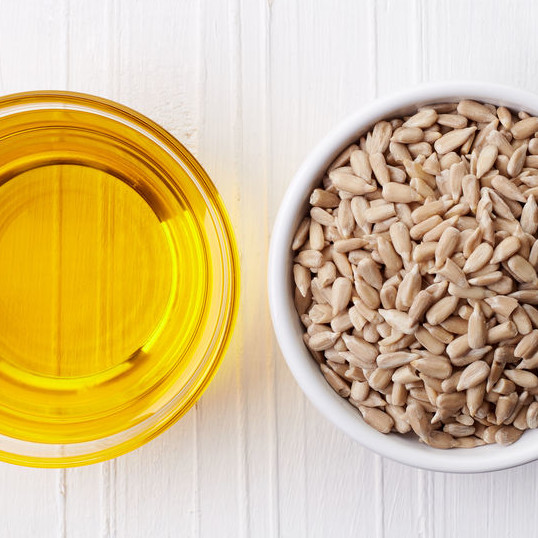Sunflower Oil
What is Sunflower Oil?
Sunflower oil is a liquid fat from pressed sunflower seeds. It is rich in mono- and poly-unsaturated fatty acids, particularly oleic and linoleic acids. It is low in saturated fatty acids such as palmitic and stearic acids.
In the baking industry, sunflower oil is favored for its mild flavor and low smoke point (232 oC/450 oF). It can be incorporated into cakes, breads, pizzas, cookies and muffins. It is also used in deep frying, salad dressings and margarines and shortenings.1 Three types have been developed through plant breeding and commercialized:1
- High linoleic (69% linoleic acid)
- Mid- oleic (65% oleic acid)
- High oleic (>80% oleic acid)
Origin
Sunflower (Helianthus annuus L.) domestication is attributed to the Americas region mainly Mexico and Southern U.S. Around 1510, the plant was introduced to Europe by Spanish explorers. The evolution of the sunflower seed as an oil crop was developed in Russia in the late 1800’s. By the mid 19th century, sunflower seed was reintroduced to North America.1 Today, sunflower oil is mostly produced by Russia, Ukraine and Argentina.
Function
Sunflower oil serves several purposes in baked goods:2
- Tenderizing and lubrication: by coating structure building components (gluten, starch and egg proteins), it prevents them from hydrating and building structures.
- Moistness, softness and extensibility: by lubricating structure builders, it creates the sensation of moistness and softness and provides dough stretchiness.
- Prevents staling: by retarding starch retrogradation and gelatinization.
- Flavor: provides a mild flavor without interfering with the baked product’s own flavors.
- Color: indirectly by increasing heat necessary for baking and subsequent increase in the rate of browning.
- Smoothness: by interfering with and disrupting sugar crystallization.
- Flavor carrier: many flavor compounds are dissolved in sunflower oil to help disperse them.
- Release agent: aids in the removal of baked goods from molds.
Nutrition
Oleic, linoleic and linolenic content of the three main types of sunflower oils can be found in the following table:1
| Oil type | Oleic | Linoleic | Linolenic |
| Linoleic | 18.7% | 67.5% | 0.8% |
| Mid- linoleic | 60.4 | 30.6 | – |
| High oleic | 81.3 | 9.0 | – |
Smaller amounts of palmitic, arachidonic and other fatty acids can be found in sunflower oil. In addition to its desirable high content of both monounsaturated and polyunsaturated fatty acids, sunflower oil is rich in vitamin E (5.6 mg/4.67 g oil). All these components are considered beneficial in reducing the risks of heart disease.
Commercial production
Sunflower oil can be commercially obtained through the following process:1,3
- Cleaning: removal of foreign matter such as dirt and stalks.
- Dehulling: removal of hulls using mechanical impact and air separation.
- Flaking: seeds are flaked to aid in oil extraction by passing through several rollers.
- Cooking: seeds are cooked and dried down to 4-5% moisture at 90-100°C (194-212°F).
- Pre-pressing: the cell structure is disrupted with a set of rollers. 65% oil extraction.
- Pre-clarification: solids in the oil settle in a tank, and are later removed.
- Solvent extraction: cake is extracted with a solvent, typically hexane.
- Desolventizing: removal of remaining hexane in the cake.
- Distillation: removal of the hexane present in the oil.
- Degumming: removal of phospholipids from the crude oil with an acid-oil mixture.
- Refining: further removal of phospholipids with addition of an acid mixture, and removal of free fatty acids with an alkali solution.
- Bleaching: removal of pigments and other contaminants with bleaching clay.
- Deodorization: removal of undesirable odors.
Application
Sunflower oil can be used in several baking formulations such as cakes, cookies, muffins and breads.1
Margarines and shortenings made with sunflower oil are used in baking applications and can replace butter or shortenings in many cases. Bakers, however, should expect a denser consistency which can be adjusted by using blends of sunflower oil:butter (3:1 ratio).1
Regulations
Sunflower oil is considered GRAS by the FDA. In the EU, sunflower oil is recognized as safe and it’s regulated by the EC Regulation 1107/09/EC.4,5
References
- O’brien, R. D. Fats and oils: formulating and processing for applications. CRC press, 2009, pp. 28-33.
- Figoni, P. How Baking Works: Exploring The Fundamentals Of Baking Science. 2nd ed., John Wiley & Sons, Inc., 2008.
- Martínez-Force, E., Dunford,N.T and Salas, J.J. Sunflower: chemistry, production, processing, and utilization.AOCS Press, 2015.
- Food and Drug Administration (FDA). US Department of Health and Human Services. CFR Code of Federal Regulations Title 21, Part 117 Current Good Manufacturing Practice, Hazard Analysis, And Risk-based Preventive Controls For Human Food, https://www.accessdata.fda.gov/scripts/cdrh/cfdocs/cfCFR/CFRSearch.cfm?fr=117.5, Accessed 23 August 2020.
- European Commission (EC). Commission Regulation 1107/09/EC concerning the placing of plant protection products on the market and repealing Council Directives 79/117/EEC and 91/414/EEC . Official Journal of European Communities, 21 October 2009.


